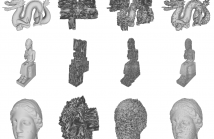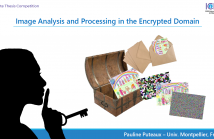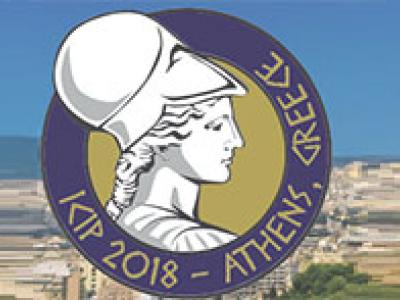
- Read more about A FORMAT COMPLIANT ENCRYPTION METHOD FOR 3D OBJECTS ALLOWING HIERARCHICAL DECRYPTION
- 1 comment
- Log in to post comments
With the increasing popularity of 3D objects in industry and everyday life, 3D object security has become essential. While there exists methods for 3D selective encryption, where a clear 3D object is encrypted so that the result has the desired level of visual security, to our knowledge, no method exists for decrypting encrypted 3D objects hierarchically. In this paper, we are the first to propose propose a method which allows us to hierarchically decrypt an encrypted 3D object according to a generated ring of keys.
- Categories:
 45 Views
45 Views
- Read more about Stealthy Backdoor Attack With Adversarial Training
- Log in to post comments
Slides.pdf
- Categories:
 34 Views
34 Views
- Read more about Applying deep learning to known-plaintext attack on chaotic image encryption schemes
- Log in to post comments
In this paper, we demonstrate that traditional chaotic encryption schemes are vulnerable to the known-plaintext attack (KPA) with deep learning. Considering the decryption process as image restoration based on deep learning, we apply Convolutional Neural Network to perform known-plaintext attack on chaotic cryptosystems. We design a network to learn the operation mechanism of chaotic cryptosystems, and utilize the trained network as the decryption system. To prove the effectiveness, we select three existing chaotic encryption schemes as the attacked targets.
- Categories:
 24 Views
24 Views
- Read more about STEP-GAN: A One-Class Anomaly Detection Model with Applications to Power System Security
- Log in to post comments
Smart grid systems (SGSs), and in particular power systems, play a vital role in today's urban life. The security of these grids is now threatened by adversaries that use false data injection (FDI) to produce a breach of availability, integrity, or confidential principles of the system. We propose a novel structure for the multi-generator generative adversarial network (GAN) to address the challenges of detecting adversarial attacks. We modify the GAN objective function and the training procedure for the malicious anomaly detection task.
- Categories:
 26 Views
26 Views
In this research project, we are interested by finding solutions to the problem of image analysis and processing in the encrypted domain. For security reasons, more and more digital data are transferred or stored in the encrypted domain. However, during the transmission or the archiving of encrypted images, it is often necessary to analyze or process them, without knowing the original content or the secret key used during the encryption phase. We propose to work on this problem, by associating theoretical aspects with numerous applications.
- Categories:
 158 Views
158 Views
- Read more about Privacy Protection for Social Media based on a Hierarchical Secret Image Sharing Scheme
- Log in to post comments
Social network development raises many issues relating to privacy protection for images. In particular, multi-party privacy protection conflicts can take place when an image is published by only one of its owners. Indeed, privacy settings applied to this image are those of its owner and people on the image are not involved in the process. In this paper, we propose a new hierarchical secret image sharing scheme for social networks in order to answer this problem.
- Categories:
 15 Views
15 Views
- Read more about Chained Compressed Sensing for IoT Node Security
- Log in to post comments
Compressed sensing can be used to yield both compression and a limited form of security to the readings of sensors. This can be most useful when designing the low-resources sensor nodes that are the backbone of IoT applications. Here, we propose to use chaining of subsequent plaintexts to improve the robustness of CS-based encryption against ciphertext-only attacks, known-plaintext attacks and man-in-the-middle attacks.
poster-ICASSP2019.pdf
- Categories:
 26 Views
26 Views
The cloud-based speech recognition/API provides developers or enterprises an easy way to create speech-enabled features in their applications. However, sending audios about personal or company internal information to the cloud, raises concerns about the privacy and security issues. The recognition results generated in cloud may also reveal some sensitive information. This paper proposes a deep polynomial network (DPN) that can be applied to the encrypted speech as an acoustic model. It allows clients to send their data in an encrypted form to the cloud to ensure that their data remains confidential, at mean while the DPN can still make frame-level predictions over the encrypted speech and return them in encrypted form. One good property of the DPN is that it can be trained on unencrypted speech features in the traditional way. To keep the cloud away from the raw audio and recognition results, a cloud-local joint decoding framework is also proposed. We demonstrate the effectiveness of model and framework on the Switchboard and Cortana voice assistant tasks with small performance degradation and latency increased comparing with the traditional cloud-based DNNs.
https://ieeexplore.ieee.org/document/8683721
- Categories:
 22 Views
22 Views
- Read more about A FORMAT-COMPLIANT SELECTIVE SECRET 3D OBJECT SHARING SCHEME BASED ON SHAMIR’S SCHEME
- Log in to post comments
New issues have arisen in the creation of 3D objects linked to collaboration in 3D workflows. In this kind of usage it may be necessary to allow access and to share a lower quality file of a 3D object for some collaborators.
In this paper, we present a Format-Compliant Selective Secret 3D Object Sharing (FCSS3DOS) scheme, which visually protects the content using geometrical distortions by selectively sharing bits of a 3D object's geometry using Shamir's Secret Sharing scheme.
- Categories:
 13 Views
13 Views
- Read more about Learning Sensitive Images using Generative Models
- Log in to post comments
The sheer amount of personal data being transmitted to cloud services and the ubiquity of cellphones cameras and various sensors have provoked a privacy concern among many people. On the other hand, the recent phenomenal growth of deep learning that brings advancements in almost every aspect of human life is heavily dependent on the access to data, including sensitive images, medical records, etc. Therefore, there is a need for a mechanism that transforms sensitive data in such a way as to preserves the privacy of individuals, yet still be useful for deep learning algorithms.
- Categories:
 17 Views
17 Views